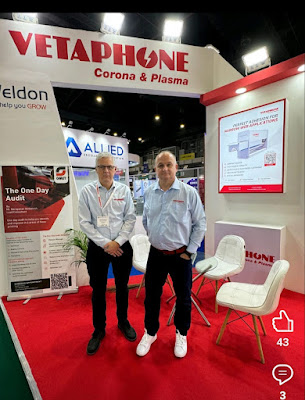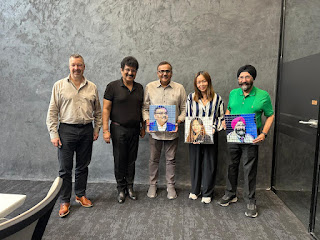 |
| Opening Ceremony |
This was the first Labelexpo
India after the holding company Tarsus PLC, the erstwhile owners of Labelexpos
were acquired by Informa markets, a global organizer of events in various
global verticals. Since the new owners decided to retain the same team of
labelexpo, the smooth transition and continuation was evident.
It
was the largest show until now. The show was held at India Expo Mart, Greater
Noida with a 30% higher floorspace than the 2022 edition. The largest ever
number 13724 visitors came to show from, besides India, many
countries including those in Middle East, Russia and Africa. Normally we see
only label printers and non-exhibiting suppliers as visitors to the show, this
time it was a welcome change to see quite a few brand owners/Print buyers as
visitors studying the nuances of label manufacturing. It is felt that with the
growing need for customized runs and increasing number of startups, some label
buyers may be considering captive label production as well.
 |
| Rajesh Chadha President LMAI |
Inaugurating the Labelexpo India 2024, Jade Grace Managing Director welcomed the visitors to this important event. In his welcome address, Rajesh Chadha President LMAI assured LMAI's continued support and delivering value to the label fraternity. After consultations
with LMAI and other stakeholders, Informa Markets have decided to hold the next
edition of this important event at the same venue in 2026.

For the past
two consecutive editions of Labelexpo India we have witnessed the absence of European
and American flexo label presses running live at the event, though some made
their presence felt through their local agents or Indian subsidiaries. However
still, there were many flexo label presses displayed, and most of them were
Indian made ones followed by a few from China. It is an indication of a
transformation that one can expect Indian and Chinese manufacturers of flexo presses,
tooling and consumables will have increasing number of exhibitors at Labelexpo
Europe. The transformation is happening by the evolution of technologies taking
place in these Asian neighbours. Fewer Chinese companies came as exhibitors due
to Visa restrictions, which may change with thaw in the relations between the
countries. Of course, we cannot write off the western manufacturers who lead
the way to evolution by creating equipment that transforms from production of only
labels to produce multiple products like Flexible packaging, Lami tubes and
Folding Cartons. Their focus is now moving to wider presses, which are hybrid,
incorporating diverse printing and converting technologies resulting in lesser
wastages, quick changeovers, increased embellishments, sustainable production and
processes. The presses now being offered integrate flexo, offset, screen, gravure
and digital inline in a single pass.
 |
| Pulisi stand |
Digital label
printing has also continued to grow in India. Most prominent companies
including HP, Domino, Durst, Xeikon, Konica Minolta, Pulisi, etc. displayed
their digital presses and label printers’ interest was seen in with serious
intent. Indian label industry being mostly dominated in numbers by family
managed middle and lower end companies find the high-end digital presses being
beyond their immediate reach even though their desire to acquire digital
printing capabilities was seen in substantial measure. Printers exhibited a lot
of interest in entry level tabletop digital printing equipment. These digital
printers though are priced lower, but their higher printing cost confuses converters.
Those who understood the power of digital making its necessity felt in label
manufacturing, did make purchase decisions at the show. Given the trend of the
middle level label companies looking at entry level equipment, it indicates
that it is just some more time before they graduate to the bigger digital label
and package printing equipment. The transformation has begun. The industry is and
firmly marching towards digital label printing and converting.

On the material
side while the global leaders Avery Dennison displayed their innovations and
advances especially in the RFID label technologies and linerless labels. UPM
too exhibited their new and sustainable product offerings. A substantial number
of Indian labelstock manufacturers put their best in front rubbing shoulders
with the multinational material producers. Prominent amongst them were SMI,
MLJ, Capri, Stic-on, Dubble, Desmat and many others. Silicone liners specialist
Loparex exhibited their diverse range of backing papers, films and linerless
materials. Sustainability seems to be catching up the attention of all in the self-adhesive
label’s ecosystem. From equipment suppliers to material suppliers are now
talking of sustainability endeavours and the imperative need for the 4R’s, reduce,
reuse, recycle, and recover. Indeed, this is a welcome transformation. Yet,
there is a lot more needed, and the onus is also on brand owners and print
buyers to impress suppliers to implement sustainable manufacturing practices
and to use FSC certified products and to conserve energy.
 |
| Harveer Sahni's book launch |
In the second half of 14th
of November, the opening day of Labelexpo India 2024, the author’s book titled
“Untold stories of Indian label industry” was launched at the HP stand in
presence of Industry leaders and media. Prominent were Yoav Lotan, Appadurai
and team from HP, Anil Sharma, Pankaj Bhardwaj and Saurabh Agarwal from Avery
Dennison, Rajesh Chadha president and his leadership team of LMAI, Media
presence included Labels & Labeling, Printweek, Packaging South Asia,
Packman, Press Ideas along with a host of industry friends and supporters of
the author. The Hp team hosted the event supported by Avery Dennison, LMAI
(Label Manufacturers Association of
India and Pragati Pack.

The book UNTOLD STORIES OF INDIAN LABEL INDUSTRY” Author: Harveer Sahni, chronicles history of
Indian labels industry from the very beginning when the first self-adhesive
label was produced manually. It covers success stories, lives of leading label printers and coverage of important
label events in India. It also dwells on the most defining moments, the young
czars of label industry and the women who lend glamour to the vibrant label
Industry. It is the first of its kind of endeavor anywhere in the world. It is
a 320-page coffee table book with rare pictures.
 |
| Lighting the lamp before Awards evening |
On the second
evening of Labelexpo India the LMAI Gallus-HEIDELBERG Label Awards night was
held to commemorate the finest of label printers in India. An outstanding event
curated under the exacting and fine detailed planning leadership of event
chairman and past president of LMAI Kuldip Goel. The virtual who is who of
Indian label industry was present. The event interspaced with entertainment
slots was attended by over 700 delegates from the global label industry.
 |
| Felicitating Ferdi and his wife |
A touching
part of this evening was bidding farewell to Industry stalwart Ferdinand Ruesch
IV, senior vice president, global key accounts at Gallus, popularly known as
Ferdi who is retiring after 40 years of dedicated service to the global
printing and packaging industry. It was a nostalgic moment and will remain
memorable forever.
The evening ended with music, dance and partying, looking
forward to yet another vibrant LMAI event.
More images:
 |
| LMAI BOD with event organiser Hemal |
 |
| LMAI Board of Directors |
With Ashima Ahuja of Multitec Pradeep Saroha of Informa
 |
| Monotech Stand |
 |
| Multi Hi-tech |

Written and compiled by Harveer Sahni Chairman Weldon Celloplast Limited New Delhi November 2024



















































